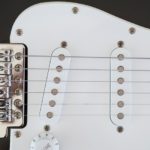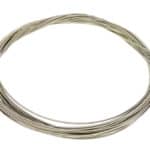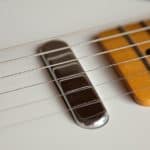Many guitarists find themselves wanting to change up their string size, maybe this is due to breaking strings or just wanting to try something new.
There’s a lot of mystic about string gauges, but not that much objective information available.
This is particularly true if you are just starting out and are fed all the myths many players have spread for years.
So to tackle this issue quickly:
Should you set up your guitar again every time you change string gauge?
You don’t necessarily need to modify the setup of your guitar after changing string gauge. The need for doing so will depend exclusively on the playability of your instrument after the change. If you notice neck relief, fret buzz, or an uncomfortable string action, these are signs that a setup is required.
There are a lot of things to consider when dealing with string gauges and setup, so if you want to dive deeper into this topic, I recommend you stick with me for a while.
In this article, I will build from the basics to answer the most common questions you might have.
Are you ready to get started?
Let’s go!
What is a guitar setup?
A guitar setup is balancing, leveling, and intonating a guitar to make it play to the best of its ability, as comfortably as possible.
Usual brand new guitars need a setup right out of the box, or maybe it’s just been a while and the guitar needs an adjustment after years of use!
It’s a common thing every guitar player needs, usually done by a professional but in many cases, it can be a learned skill that you can do at home.
What does a different string gauge mean for the instrument?
Different string gauges result in varying string tension, essentially meaning more pull and strain on the neck/body of the guitar.
Usually, a string gauge change would be for personal preference of feel, but in other cases, it’s for a special purpose or string type to achieve a special job on a guitar, such as flat wound strings for jazz/surf or 13’s for drop tuning.
There are no actual rules about string gauges, so it’s all a matter of experimentation and finding out what feels best for your playstyle.
In the following article, I also touch upon this topic:
What could happen if you don’t set up your instrument after a string gauge change?
If it’s a small change from 10s to 11s, probably not much.
With a hardtail guitar, you most likely will only notice a difference in string height or some slight buzzing.
When making massive changes, say from 10s to 12s or 14s, you might notice HUGE problems in the guitar, especially if you are not down tuning the instrument.
If you are new to string gauge changes, it’s important to talk to a local guitar tech and ask for help and advice before making a switch.
Another thing to consider is if the gauge change will come in hand with a change in tuning.
This is because, in some cases, a lower tuning might compensate for the added tension of a thicker string gauge.
In this article you can read more about tuning changes and guitar setups:
Can a change in string gauge damage your instrument if it’s not set up properly?
In most cases, a change in string gauge will not damage your instrument.
Of course, we are talking about reasonable things here, right?
Putting bass strings on a ukelele will make it fold in half.
But if you are planning to go from 09 strings to 10s, or perhaps higher, likely it will just become uncomfortable to play and in some cases impossible at worst.
If you make a massive change, it could have an effect on the neck if action is taken, but an issue like that can almost always be resolved with a truss rod adjustment and bridge leveling.
It’s extremely unlikely for your guitar to suffer permanent damage just for a simple string change, as radical as it could be.
As long as the new strings fit without any modifications to any of the parts of the guitar, it all will probably be fine.
Floating bridges will likely always require a re-setup when you change string gauge
As nice as it is having a floating bridge, more likely than not if you change your string gauge you will have to get the guitar rebalanced.
This is especially the case with Floyd rose/locking tuner guitar bridges, which are delicate.
Floating bridges work with a series of springs that compensate for the tension the strings exert in the opposite direction.
It’s natural that if you change the gauge of the strings, the tension they apply to the bridge will change, and thus you will need for the springs to adjust.
No need to stress though, the setup is a simple thing once you have the proper tools and knowledge.
Can you set up your guitar by yourself?
You surely can, it will require some learning, trial, and error.
Watch some videos on youtube, try on an old guitar if you have one, and find what is comfortable for you.
Companies like Ernie Ball and D’Addario sell rather affordable guitar repair kits that will have all the tools needed to do a great setup on your instrument.
Take your time, ask questions, and don’t mess with the truss rod until you need to, because if that breaks it’s going to be a HUGE problem.
How much would it cost me to have a technician do the setup?
Most guitar techs will charge somewhere between $50-100 for a basic string change and setup, but if more advanced work is required the price will definitely go higher.
If you are getting your guitar setup it might be the perfect time to get other work done like new pickups or a fret dressing, the possibilities are endless!

Hello there, my name is Ramiro and I’ve been playing guitar for almost 20 years. I’m obsessed with everything gear-related and I thought it might be worth sharing it. From guitars, pedals, amps, and synths to studio gear and production tips, I hope you find what I post here useful, and I’ll try my best to keep it entertaining also.





